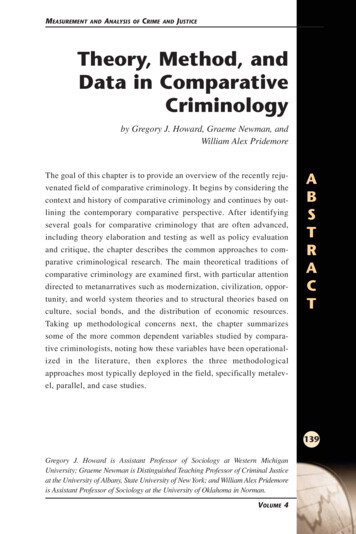
Transcription
MEASUREMENTANDANALYSISOFCRIMEAND JUSTICETheory, Method, andData in ComparativeCriminologyby Gregory J. Howard, Graeme Newman, andWilliam Alex PridemoreThe goal of this chapter is to provide an overview of the recently rejuvenated field of comparative criminology. It begins by considering thecontext and history of comparative criminology and continues by outlining the contemporary comparative perspective. After identifyingseveral goals for comparative criminology that are often advanced,including theory elaboration and testing as well as policy evaluationand critique, the chapter describes the common approaches to comparative criminological research. The main theoretical traditions ofcomparative criminology are examined first, with particular attentiondirected to metanarratives such as modernization, civilization, opportunity, and world system theories and to structural theories based onculture, social bonds, and the distribution of economic resources.Taking up methodological concerns next, the chapter summarizessome of the more common dependent variables studied by comparative criminologists, noting how these variables have been operationalized in the literature, then explores the three methodologicalapproaches most typically deployed in the field, specifically metalevel, parallel, and case studies.ABSTRACT139Gregory J. Howard is Assistant Professor of Sociology at Western MichiganUniversity; Graeme Newman is Distinguished Teaching Professor of Criminal Justiceat the University of Albany, State University of New York; and William Alex Pridemoreis Assistant Professor of Sociology at the University of Oklahoma in Norman.VOLUME 4
THEORY, METHOD,ANDDATAINCOMPARATIVE CRIMINOLOGYWith the growth of international “transparency” and the capacity of theWorld Wide Web to disseminate information, data about crime and justicearound the world are more accessible then ever. The chapter discusses thethree most common types of data on international crime and justice (i.e.,official, victimization, and self-report data), describing the threats to thereliability and validity of each type and directing interested readers to existing sources of data relevant to frequently employed explanatory concepts.ABSTRACT140In conclusion, the chapter observes that, while comparative criminology is agrowing area of study owing to the influence of globalization and concernsabout transnational crime, the relative neglect of systematic comparativework in criminology throughout the 20th century means that the field is stillin its infancy. Growth in this promising area of inquiry should be nurturedwith a renaissance in theory so that research is driven by theory and not bythe mere existence of more data.CRIMINAL JUSTICE 2000
MEASUREMENTANDANALYSISOFCRIMEAND JUSTICEThe History and Goals of ComparativeCriminologyThe context and history of comparativecriminologyComparative criminology is as old as criminology itself. Beccaria,Bentham, Voltaire, Helvetius, Quetelet, and many others of the 18th-centuryEnlightenment compared and contrasted their own systems of justice with thoseof other nations. Their recommendations and findings were often influentialin bringing about change in countries other than their own. Indeed, the U.S.Constitution owes some of its language and ideas to the writings of these thinkers(see Granucci 1969; Schwartz 1971). Yet, for most of the 19th century andmuch of the 20th century, comparative criminology was neglected as nationslooked inward for solutions to their specific crime problems. It was not untilthe middle and late decades of the 20th century that interest again emerged incomparing and contrasting the problems of crime across nations. There aremany reasons for this renewed interest. The most obvious is that the latter halfof the 20th century saw the world become a smaller place, a transformation initiated by revolutions in communication, transportation, and information technology. At the close of the 20th century, nations are increasingly pressured toaccount for their actions, and the activities of nations are transparent as neverbefore.One can reasonably argue that transparency began in economic institutions,where trade and commerce demanded it. But the availability of informationabout various facets of national social life has flourished as well, some haveargued, because of an abiding concern with the health of democracy. KennethPrewitt, current Director of the U.S. Census Bureau, has suggested, “A healthydemocracy needs a healthy number system, and anything that erodes that number system undermines democracy” (American Sociological Association 1999,3). Gradually, countries have collected and made available to the internationalcommunity statistics on a wide range of subjects relevant to the interests ofcomparative criminologists (see, for example, United Nations DevelopmentProgramme 1998). Among these data are statistics on crime and criminal justice, which have only recently become widely accessible at the internationallevel (Newman 1999). Although nations formerly guarded information oncrime and criminal justice zealously, many nations now provide these data onthe Internet, where they are available to anyone with adequate technologicalresources. The transparency and availability of such information have created aclimate in which the promises of comparative criminological research may berealistically pursued.VOLUME 4141
THEORY, METHOD,ANDDATAINCOMPARATIVE CRIMINOLOGYAlthough many theoretical, methodological, and philosophical problems certainly have dogged comparative criminology since its inception, there is littledoubt that this field of investigation is currently in a state of rapid expansion.While this chapter outlines some of the main problems that confront comparative criminology, the discussion also focuses on what cross-national researchhas accomplished and what it can do for the field of criminology in the future.We begin with two questions often asked of comparative criminology: What isthe comparative perspective, and why employ it? Following this discussion, wemove to a consideration of the substantive and theoretical issues that lie at theroot of comparative criminological inquiry. We must begin with theory, becausethe plethora of databases and other information now available from many countries provides an environment that tempts rash comparisons and sometimesunsubstantiated conclusions based on what may be incomparable data. Facedwith such a challenge, theoretically informed research supported by soundmethodology is the wisest defense. Consequently, we look at the theoreticalperspectives that have been brought to bear in understanding crime from acomparative perspective. Following this, we consider crime as a dependent variable in comparative work, then stake out the methodological approaches that areoften used in this type of investigation. We then consider the data available toresearchers interested in pursuing comparative studies and conclude with someobservations about the future of comparative research in criminology.The comparative perspectiveGlobalizationIn its broadest sense, all social science research is comparative. As Durkheimnoted: “Comparative sociology is not a special branch of sociology; it issociology itself” ([1895] 1938, 157). To the extent that the scientific methoddepends on comparison, Durkheim is no doubt correct. But comparative criminology demands more than comparison. Comparative investigations do notinvolve so much a method as a perspective, one that demands a gestalt thatin today’s terminology might be called a global view. It may be argued thatapplying today’s global perspective to comparative criminology is misleadingbecause comparative studies of crime have been in existence for two centuries.Yet, comparative research has received relatively little attention from scholarsin our field. Marsh noted in 1967 that a tiny number of articles in social sciencejournals at that time dealt with crime in two or more cultures, and Beirne(1997, xiii) pointed out that this lack of interest persisted into the 1980s. It isclear, however, that engagement in comparative criminology has increased significantly in the last decade (see Adler, Mueller, and Laufer 1994; Ebbe 1996;142CRIMINAL JUSTICE 2000
MEASUREMENTANDANALYSISOFCRIMEAND JUSTICEMoore and Fields 1996; Reichel 1994). One major reason is simply that aglobal perspective on all popular subjects now dominates the world.The nation-state and the universality of the criminaljustice systemIt has become increasingly clear that much of what we call criminal justicedepends to a large extent on the operations and structure of modern nationstates. It is the modern nation-state that has given us the tripartite criminaljustice system (i.e., police, courts, and corrections) as it is commonly studiedtoday (Newman 1999). Though it may rest within diverse legal traditions andcultures, this basic tripartite structure is similar in all modern nation-states (forauthoritative discussions on legal traditions, see David and Brierley 1985 andWigmore 1936), and investigations that compare nations do so on the assumption that these nations have similar structures of criminal justice. Thus, moreattention has been given recently to comparing whole nations in addition tocomparing cultures. This is partly the result of globalization, but much is due tothe more easily definable boundaries and structures of nation-states when compared with cultures. (The latter, of course, often transcend national boundaries.)The single most important difference between cultures and nation-states is thatnation-states are political entities while cultures are ways of life. Nation-statesmay be composed of many cultures, as the recent war in the former Yugoslaviaattests, and a single culture (depending on how broadly the term is defined)may span several countries (e.g., Roman Catholicism,Islam, Judaism, American popular culture). BecauseThe greatestthe nation-state is the operational basis for the crimecontrol activities of criminal justice agencies, andadvantage—because it is more easily defined than the elusivealthough oftenconcept of culture, most recent comparative workconsidered anin criminology has examined similarities and differimpediment—forences with respect to the nation-state (or relevantresearchin comparpolitical subdivisions such as the state or province).ative criminology isthe great diversityDefinitional diversity of crimethat exists crossOne endemic problem confronting comparative crimnationally withinology is the enormous diversity in the way differentregard to social,cultures and nation-states define crime, justice, andeconomic, andother relevant concepts. As we shall see, this has notstopped many researchers from conducting a widepolitical indicators.variety of studies comparing crime and delinquencyVOLUME 4143
THEORY, METHOD,ANDDATAINCOMPARATIVE CRIMINOLOGYaround the world. Many of these researchers have attempted to resolve thisproblem by adjusting legally defined crime categories into socially defined categories, many of which conform to various common theories about the functions and patterns of cultures and social structures in society (see the discussionof victimization surveys by van Dijk 1999). Others have managed to reclassifythe official legal definitions of national crime categories into general crime categories to which nations can match their crime definitions (e.g., the UnitedNations Surveys of Crime and Criminal Justice Systems). But these solutionsare only partial and many problems remain.Advantage of diversity for comparative criminologyThe greatest advantage—although often considered an impediment—forresearch in comparative criminology is the great diversity that exists crossnationally with regard to social, economic, and political indicators. Thoughtheir structure and organization may vary, basic social and cultural categoriessuch as family, urban and rural life, and community are universals of humanexistence, so they may be used as fundamental classifications when comparingone cultural group with another. Similarly, as previously noted, the criminaljustice system deploys basic categories that may be used to guide comparisonsof one nation to another. All nations have police, all have courts, and all have aprison system. However, elements of these parts of the criminal justice systemdiffer widely, as do their relationships with each other, and recent comparativestudies of criminal justice focus especially on these differences to derive policyand management implications. Of course, the scientific significance of the findings of cross-cultural and cross-national research depends on the deeper questions that one wishes to answer, and these questions are related to the aims andgoals of comparative (or any kind of social science) research.In sum, the comparative perspective is an approach that employs basic unifyingconcepts of human groups and seeks to compare cultures and nation-states tohighlight the similarities and differences between each class with respect tothese universal concepts. These comparisons are achieved in many ingeniousways, often depending on the home discipline of the researcher, and have produced rich information. Some of this information is explanatory in a traditionalcausal sense (i.e., the ordering in space and time of variables and events) andother information provides descriptive evidence of diversity, which also servesas the source of many questions for future research. The scientific merit of thisinformation may well be questioned, however, depending on the methodologyand data sources employed. It is a great problem of comparative research thatthe data sources are, virtually by definition, influenced by the cultures andnation-states from which the information is extracted and by the cultural commitments of investigators themselves. These are standard problems of scientific144CRIMINAL JUSTICE 2000
MEASUREMENTANDANALYSISOFCRIMEAND JUSTICEresearch, however, and attention will be paid to these issues in cross-nationalterms in the pages to come.The goals of comparative researchThere are several goals of comparative research in criminology. Some are obvious applications of the traditional canons of the scientific method, and someare unique to the study of crime in an international setting. Although comparative criminology attends mainly to understanding criminal and deviant behavioras it is manifested globally, these studies will inevitably yield useful insightsabout the control of antisocial activity. Thus, the study of criminology will naturally intersect with the field of criminal justice if criminological observationsare taken to their logical policy conclusions. With respect to the scientificimport of comparative work in criminology, a few important goals are notedhere.Extending theories beyond cultural and national boundariesComparative research provides an opportunity for criminological theories,which are typically generated within the context of particular nation-states, tobe given a wider hearing (Mueller and Adler 1996). Do the theories developedto explain crime rates in the United States, Finland, Japan, or South Africaserve with equal force to account for criminal violations in other nations aroundthe world? Do theories that try to account for the police use of force in theUnited States, Russia, Australia, or Brazil help to understand police behaviorin other countries? These are questions of replication, and they stand at theheart of the scientific enterprise. Beside permitting criminologists to assess thegeneralizability of important theoretical propositions, comparative research alsoassists in the elaboration and specification of theory. If a specific theoreticalmodel does not account for variations in crime in other nation-states, perhapssome refinement can be identified on the basis of this investigation, therebyimproving the explanatory power of the theory. Finally, as the world becomesa smaller place through the expansion of globalization and crime and criminaljustice become increasingly transnational as a result, comparative investigationsensure that theories of crime and criminal justice will remain relevant to theexigencies of history.Assessing the performance of national criminal justicesystemsAnother important goal for comparative work in criminology is the assessmentof national criminal justice systems. For example, an article by Maguire,Howard, and Newman (1998) developed an index by which the performanceVOLUME 4145
THEORY, METHOD,If the various institutions of criminaljustice (i.e., police,courts, and corrections) are to work asa system chargedwith the control ofcriminal behavior,there must be someway to assess theirperformance as anoperational unit.ANDDATAINCOMPARATIVE CRIMINOLOGYof national criminal justice systems can be validlycompared across nations. The idea of a criminaljustice system is of relatively recent vintage, mostforcefully espoused in the 1967 report of thePresident’s Commission on Law Enforcement andAdministration of Justice, The Challenge of Crimein a Free Society. Despite this conceptualization ofcriminal justice, which aims to make the practices ofcrime control more efficient and less fragmented, thepromise of the system idea has hardly been realizedmore than 30 years later, as Inciardi’s (1984) characterization of the U.S. criminal justice system as anonsystem suggests.An index of national criminal justice systems’ performances, however, can serve to overcome thefragmented operations of the administration of justicethat have been so widely attacked in the academic literature and popular media alike. In short, if the various institutions of criminaljustice (i.e., police, courts, and corrections) are to work as a system chargedwith the control of criminal behavior, there must be some way to assess theirperformance as an operational unit. The performance measures of nationalcriminal justice systems establish this type of benchmark. Moreover, comparisons of the performance of national criminal justice systems inevitably raisequestions of policy and, in the long run, of justice. These are questions forwhich comparative criminologists should be able to field reasonable answers.Evaluating national criminal justice policyComparative criminology and criminal justice also promise to yield insightsinto the efficacy of various policy initiatives. For instance, are high levels ofgun violence inevitable in the United States because it harbors a gun culture?Perhaps there are other countries that have a high level of gun ownership but alow rate of gun crime (see Killias 1993). Would the legalization of drugs leadto an epidemic of drug use, as is often argued? Perhaps other countries havehad a different experience. This is not to say that experiences with crime and itscontrol in one nation should be copied wholesale to another. But when we seedifferent and successful ways of dealing with crime in other countries, we atleast know that it is possible and that the current state of affairs in a particularcountry is not preordained or inevitable. The work of the International Centerfor Crime Prevention has done much to highlight success stories in crime prevention throughout the world (Waller and Welsh 1999).146CRIMINAL JUSTICE 2000
MEASUREMENTANDANALYSISOFCRIMEAND JUSTICECoordinating the fight against transnational crimeAnother response often provided to the question of “Why do comparative criminology?” maintains that the globalization of crime, as expressed in the increasingly popular notion of transnational crime, points to the need for a coordinatedor transnational criminal justice response. Here the benefits of comparativecriminology extend beyond the merely provincial and become more fully universal (Reichel 1994). Central to the prosecution of coordinated efforts, Mooreand Fields (1996, 6) contend, is “greater international understanding” because“the more one knows about another people, society, or culture, the greater thepotential for understanding their actions and responses to problems and situations.” Put more pragmatically, a coordinated law enforcement response totransnational crime such as money laundering or drug trafficking requires thatthe interested parties understand something of the characteristics of transnational criminals and recognize the operational strengths and weaknesses of oneanother’s crime control systems. Providing this type of information is oneimportant goal of comparative criminology.CritiqueIn contrast to the previous point, a final reason for pursuing cross-national studiesof criminology is to provide critical scrutiny and a reasoned voice to counterwhat may often seem to be a knee-jerk embrace of all things global. In the rushto counter what is rather vaguely referred to as the threat of transnational crime,significant freedoms and human rights may be sacrificed in the name of the common, universal good. As those who have studied the historical developments ofcrime and justice in the United States must be painfully aware, the road to hell ispaved with good intentions. Therefore, comparative work must serve as the critical conscience of the public to ensure that the widely promoted threat of transnational crime does not lead us down a road to a dystopia that would shock eventhe likes of George Orwell. Drawing on the words of Ralf Dahrendorf (1970, 55),comparative scholars of criminology can usefully serve the role of “intellectualcourt jester” or the “fool,” questioning that which is taken for granted and doubting “everything that is obvious, [making] relative all authority, [asking] all thosequestions that no one else dares to ask.” The goal of the comparative researcherin this capacity is not to be a thoroughgoing naysayer but to strengthen policyagendas and ensure they are defensible in terms of principle and fact. Withoutsuch a critical conscience, we are in danger of becoming, like the denizens ofSamuel Butler’s ([1872] 1985, 227) Erewhon, “a meek and long-suffering people,easily led by the nose.”Having specified some parameters of the comparative perspective in criminology and identified some of the main goals of this area, we presently move toa discussion of theory in this line of investigation.VOLUME 4147
THEORY, METHOD,ANDDATAINCOMPARATIVE CRIMINOLOGYTheoretical Explanations for Criminal1Behavior in a Cross-National ContextThree general theoretical frameworks are commonly employed in explainingthe variation of crime rates among nations. The first—grand theories—aremetanarratives that entail a high level of abstraction and usually assume thatone major theoretical construct, such as a nation’s level of modernization orits placement in the world’s political economy, has the greatest impact on itslevel of crime.2 Structural theories, on the other hand, traditionally have beenemployed with smaller units of analysis, such as cities or states within a particular nation, and attempt to explain the spatial variation in rates of offending viasubcultures (i.e., social learning), status-induced strain, or social control. Thesetheoretical explanations are increasingly being tested at the cross-national level.Finally, a nation’s demographic characteristics, such as its age and sex structure, may also be employed in an attempt to explain levels of violence andproperty crime. Each section following contains a brief description of theoretical concepts, common measurements for each of these concepts, and a selectedlist of studies that analyze crime from the particular approach. In all cases, thesestudies represent theories that were originally developed within one culturaland/or national tradition but that have been recast and applied to cross-nationalresearch designs. Thus, many of the theoretical approaches will initially appearfamiliar to criminologists. However, the employment of these theories in crossnational research promises either to extend the explanatory power of these theories or to demonstrate their limitations.Grand theoriesModernization theoryDurkheim’s notion of anomie is the basis for contemporary theories thatpinpoint the effects of modernization as the main causes of crime. Durkheim([1893] 1964) argued that, as nations develop, they are characterized by anincreasingly intricate web of social and economic relations. These complexdivisions are suspected of undermining mechanical solidarity and its controlover the collective conscience. Thus, rapid social change engenders the breakdown of traditional values, resulting in, among other things, a higher crimerate. Eventually, however, organic solidarity and more formal mechanisms ofsocial control should halt rising crime rates, although they are expected toremain at higher levels than before development.Within cross-national criminology, Clinard and Abbott (1973) and Shelley (1981)have provided notable contributions to Durkheim’s idea of modernization and148CRIMINAL JUSTICE 2000
MEASUREMENTANDANALYSISOFCRIMEAND JUSTICEcrime. In short, the contention is that each nation experiences similar phases ofdevelopment. The stimulus for modernization is technological advancement, andthis catalyst leads to political, economic, and demographic changes within asociety (Strasser and Randall 1981). Industrialization and urbanization are keyelements of this social transformation. Their effects—which include the tensionbetween groups that accompanies increased social differentiation and thesocioeconomic inequality many presume to follow modernization—are viewedas the main contributors to rising crime rates (Heiland and Shelley 1992). Theoutcomes of this process are expected to provide stronger explanations of crimethan any distinct national or cultural characteristics have; thus, all nations areexpected to experience similar trends in crime rates as they develop.3 Finally,changes in both types and rates of crime are expected as a result of development. In general, the overall rate of crime is expected to increase but eventuallylevel off as modernization progresses, while another expected result is the predominance of property and economic crimes over crimes against people.Recent examples of international research on modernization and crime include: Bouley and Vaughn’s (1995) study of violent crime in Colombia, in whichregression analysis revealed support for grand theories with respect to thecrimes of theft and robbery but not for the more violent crimes of assaultand homicide. Mahabir’s (1988) work on urban gangs in the Caribbean. Industrialization and crime in the Russian region of Tuva (Balakina 1994),which official data show has the highest homicide rate in the country(Pridemore 1999). Huang’s (1995) multivariate analysis of 29 countries employing UnitedNations data, which showed support for the modernization hypothesis. Ortega and colleagues’ (1992) analysis of 51 nations using InternationalCriminal Police Organization (Interpol) crime data, which revealed supportfor the Durkheimian-modernization thesis. Johnson’s (1990) work, which examined crime and industrial development inGermany and concluded that modernization theory did not hold in this case. Matsuoka and Kelly’s (1988) study of the negative impact of resort development and tourism on Native Hawaiians. Neuman and Berger’s (1988) evaluation of modernization, Marxian worldsystem, and ecological opportunity theories, which lent only weak supportto the modernization theory.VOLUME 4149
THEORY, METHOD,ANDDATAINCOMPARATIVE CRIMINOLOGY An application of Blau’s (1977) macrostructural theory by Messner (1986),who claimed that the inequality that accompanies development is a majorreason for heightened crime rates. (Inequality and heterogeneity have beenpopular topics with cross-national researchers; see Avison and Loring 1986;Hansmann and Quigley 1982; Krahn, Hartnagel, and Gartrell 1986). Schichor’s (1985) examination of homicide and larceny rates, which indicated that development is likely to be accompanied by increased propertyand decreased violent crime.Civilization theoryWhere modernization assumes thatcrime rates willincrease and thenlevel off over time,civilization theoryexpects decreasingcrime rates as governments and theircitizens becomemore humane andcivilized.Where modernization assumes that crime rates willincrease and then level off over time, civilization theory expects decreasing crime rates as governmentsand their citizens become more humane and civilized. Civilization theory is based largely on thework of Elias (1982), who argued that social normsand manners have become increasingly refined overthe centuries. As this civilizing process occurs, individuals learn to inhibit their urges and societiesbecome less violent as a result. Self-restraint, therefore, has become the hallmark of control, not external(i.e., state) threats or punishments.As it relates to crime and control, proponents of thistheory usually focus on how the forms of officialsocial control and punishment have changed, but individual behavior obviously plays an important role.Similar to the Durkheimian ([1893] 1964) notion of modernization, these theorists contend that as industrialization expands, it creates a complex division oflabor that demands a high degree of interdependency. As this organic solidaritygrows stronger, people exercise a higher degree of internal control over theirbehavior because others increasingly depend on them (Heiland and Shelley1992). This internalization of control is expected to lead to a decrease in crimerates, especially in violence. As individuals increasingly repress their urges,however, they are likely to experience an increase in psychological pathologies(Freud 1962) and self-inflicted victimization (e.g., suicide and drug abuse).Empirical studies by criminologists with direct references to the civilizationhypothesis are rare. However, one study that does claim support for the theoryis Gillis’ (1994) work on literacy and vi
Nations Surveys of Crime and Criminal Justice Systems). But these solutions are only partial and many problems remain. Advantage of diversity for comparative criminology The greatest advantage—although often considered an impediment—for research in comparative criminology is the great diversity that exists cross-











